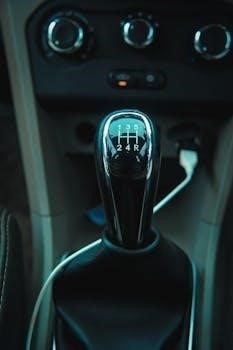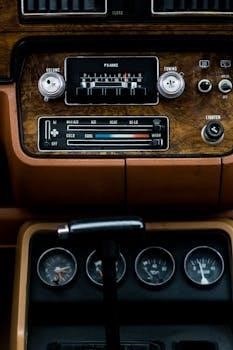Three-speed manual transmissions were a common feature in vehicles from the 1920s to the 1970s. These transmissions offered a simple and durable design, with three forward gears and a reverse gear. They were standard fare for many cars and light trucks.
Historical Overview of 3-Speed Manuals
The three-speed manual transmission’s history is rooted in early automotive development, becoming a staple in vehicles from the 1920s through the 1970s. Initially, these transmissions were the primary method of gear shifting, before the widespread adoption of automatics. They were known for their simplicity, durability, and cost-effectiveness, making them a common choice for both passenger cars and light trucks. As engine technology advanced, and more gears became necessary for optimum performance and fuel economy, the three-speed started to give way to four, five, and even six-speed transmissions. Despite their eventual decline in popularity, three-speed manuals remain a significant part of automotive history, showcasing a time when basic mechanics ruled the road.

Common Applications of Three-Speed Transmissions
Three-speed manual transmissions were widely used across various manufacturers. They were frequently found in Chevrolet, Ford, and Mopar vehicles, serving as the base transmission option for many models during their time.
Chevrolet/GM Applications
General Motors utilized three-speed manual transmissions extensively across its Chevrolet lineup. The Saginaw three-speed was a common base transmission in many models, including the Camaro. From 1964 through 1972, the manual 3-speed was standard in most of the Chevelle lineup, with exceptions for high-performance models. These transmissions were also found in Chevy trucks, with models like the M15, MM3, M62, and M64 being used in various years. A 3-speed Synchromesh Overdrive, designed by Chevrolet for better fuel economy, was also available. These transmissions were a staple for GM, showcasing their focus on basic, reliable technology in many of their vehicles.
Ford Applications
Ford also heavily relied on three-speed manual transmissions, particularly in their trucks and some of their passenger cars. The Ford 3.03 three-speed, known for its robust design, was a common choice in F-100 through F-250 trucks with a column-mounted shifter. The “3.03” designation refers to the distance in inches between the countershaft and input shaft centerlines. The Toploader transmission, initially introduced as a four-speed, also had a three-speed variant. Ford’s three-speed manuals were known for their durability and were a standard option for many years, providing a reliable, if basic, shifting experience. These transmissions were foundational to Ford’s vehicle lineup during their time.
Mopar (Chrysler, Dodge, Plymouth) Applications
Mopar, encompassing Chrysler, Dodge, and Plymouth, also made extensive use of three-speed manual transmissions. From about 1960 to the seventies, there were several three-speed gearboxes available in many models, not including Borg-Warner derivatives. These transmissions were used in both passenger cars and light truck models. Mopar’s three-speeds were known for their robustness and reliability, aligning with the brand’s reputation for durable engineering. These transmissions were designed to handle the torque of Mopar engines, providing a simple but effective means of transferring power. They were a common sight in many Mopar vehicles for many years. They provided a no-frills approach to manual shifting.

Technical Aspects of 3-Speed Transmissions
Three-speed transmissions feature specific gear ratios, often with a direct drive in third gear. Some models included synchromesh for smoother shifts. Identification can be done through codes and markings on the transmission case.
Gear Ratios in 3-Speed Transmissions
Three-speed manual transmissions typically had a set of three forward gear ratios, each designed for different driving conditions. First gear provided a lower ratio for starting from a standstill and accelerating at low speeds. The second gear offered a mid-range ratio for general driving. Third gear usually had a 1⁚1 ratio, providing a direct drive from the engine to the wheels. Specific ratios varied depending on the vehicle manufacturer and model. For example, Chevy trucks had different ratios depending on the engine size, like 2.85, 1.68, 1.00 for a 350 engine, and 3.50, 1.89, 1.00 for a 250 engine. These ratios influenced the vehicle’s acceleration, towing capacity, and fuel efficiency.
Synchromesh Overdrive in 3-Speed Transmissions
Some three-speed manual transmissions featured a synchromesh overdrive, which was a unique design that added a fourth, overdriven gear. This overdrive was not a separate gear but rather an additional ratio on top of third. It was typically engaged by a lever or switch, and it allowed the engine to run at lower RPMs for better fuel economy and reduced engine noise at higher speeds. Chevrolet’s 3-speed synchromesh overdrive was one such example. This design helped improve engine life and was particularly useful on long drives. The overdrive function made the 3-speed transmission more versatile and efficient.
Identification of 3-Speed Transmissions
Identifying a three-speed transmission typically involves looking for specific casting numbers or codes stamped on the transmission case. These numbers often correspond to a specific manufacturer and model. For instance, GM transmissions have codes like M15 and MM3, while Ford may use codes associated with their Toploader design. The location of the shift lever is also a key identifier; three-speeds often have a column-mounted shift lever, though some may have floor shifters. The physical size and shape of the transmission case can also help distinguish it from other gearboxes. These identification methods are crucial for sourcing parts and determining the correct application.
3-Speed vs Other Manual Transmissions
Compared to four and five-speed manuals, three-speeds offer fewer gear ratios. This often results in a larger gap between gears, requiring more engine torque for acceleration. They are simpler but less versatile.
Comparison to 4-Speed Manuals
The primary difference between a three-speed and a four-speed manual transmission lies in the number of forward gear ratios available to the driver. A four-speed provides an additional gear, which allows for a more refined driving experience. The extra gear in a four-speed typically bridges the gap between the lower and higher gears, enabling better acceleration and improved fuel efficiency at higher speeds, as the engine can operate closer to its optimal RPM range. This additional gear reduces the strain on the engine, especially during highway driving. Three-speeds, while simpler, often lack this refinement, with larger jumps between gears. The four-speed transmission became a popular upgrade, offering drivers a more versatile and efficient option than the older three-speed design.
Comparison to 5-Speed Manuals
Compared to a five-speed manual transmission, a three-speed is significantly less versatile. The five-speed offers two additional forward gears, allowing for finer control over engine speed and torque. The extra gears in a five-speed transmission enable the engine to operate more efficiently across a wider range of speeds, resulting in improved fuel economy and reduced engine wear. Furthermore, the additional gears allow for better acceleration and smoother transitions between speeds. In contrast, the three-speed, with its limited gear choices, often requires higher engine RPMs at highway speeds, which can lead to increased noise and decreased fuel efficiency. The five-speed provides a more modern and refined driving experience than its older three-speed counterpart.

Maintenance and Repair of 3-Speed Transmissions
Maintaining a three-speed manual often involves addressing leaks, worn synchros, and gear wear. Rebuilding these transmissions is possible with the correct parts and know-how, keeping these classics on the road.
Common Problems in 3-Speed Manuals
Three-speed manual transmissions, while robust, are susceptible to certain issues due to age and wear. Common problems include worn synchronizers, leading to grinding or difficulty shifting gears, especially between second and third. Leaks are also frequent, often stemming from seals and gaskets which dry out over time. Gear wear can cause unusual noises or jumping out of gear, particularly under heavy load. The shift linkage can become loose or misaligned, resulting in sloppy or inaccurate shifts. Proper lubrication is vital; low fluid levels can accelerate wear and tear and result in damage. These issues require attention to ensure smooth operation of the transmission.
Rebuilding 3-Speed Transmissions
Rebuilding a three-speed manual transmission is a complex task that requires mechanical knowledge and specific tools. The process begins with a complete disassembly, carefully noting the order and position of each part. All components are thoroughly cleaned and inspected for wear or damage. Worn gears, bearings, and synchronizers are replaced with new parts. The transmission case is also inspected for cracks or damage. Seals and gaskets are replaced to prevent leaks. The transmission is then reassembled, carefully following torque specifications. Finally, it is tested to ensure smooth operation. Rebuilding requires patience, precision and the correct equipment.

The Disappearance of 3-Speed Manuals
The three-speed manual transmission largely vanished from new cars after 1979, though it lingered longer in some trucks. Automatics became popular, and more gears offered better performance.
Reasons for Decline
The decline of three-speed manual transmissions can be attributed to several factors. The increasing demand for better fuel economy led to the development of transmissions with more gears. Four, five, and even six-speed manual transmissions offered finer gear ratios, allowing engines to operate more efficiently. Automatics also grew in popularity, providing greater ease of use for drivers who preferred not to shift manually. As engine technology advanced, the need for additional gears to optimize torque and power delivery became evident, making the simplicity of three-speed transmissions less desirable. Consumer preferences also shifted towards vehicles with more sophisticated features, further contributing to their obsolescence.
Modern Usage of 3-Speed Transmissions
While largely absent from modern passenger vehicles, three-speed manual transmissions still find limited use in specific applications. Some older or classic car enthusiasts actively maintain and restore vehicles equipped with three-speed manuals, preserving their historical significance. Additionally, some agricultural and industrial equipment may utilize robust three-speed transmissions due to their simplicity and durability. In certain niche markets, like vintage motorcycle restoration, these transmissions may also appear. Their straightforward design and ease of repair make them suitable for applications where advanced technology is not a priority. Consequently, three-speed manuals continue to exist, albeit in a considerably reduced capacity compared to their prominence in the past.
